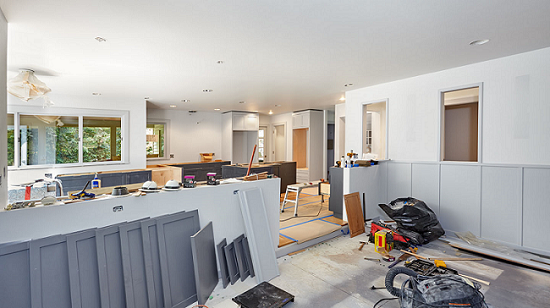What not to fix when selling a home

Quick insights
- When fixing up a home to sell, sellers may want to prioritize updates which make the home comfortable, move-in ready and ready to give a positive first impression.
- Costly repairs that don’t immediately add to the listing price or change the look and feel of the home may be best left to the new owners.
- Keep in mind that certain problems with the home, such as code violations, may be uncovered during the buyer’s inspection, and may be better resolved by the seller prior to listing.
Buyers love to hear that the home they’re considering has had recent repairs and updates. But if you’re the one listing it, what should you fix before selling a home? And what should you leave as-is? If you’re planning to sell soon, you may be wondering how to prioritize your repair budget for the best value. In this article, we’ll provide guidelines to help you decide what repairs to make before selling a house, as well as what not to fix.
Gathering information before getting started
Before you begin, it may be helpful to research the local housing market, have an inspection completed and estimate the cost of certain repairs.
Cost of repair vs. return on investment
Before undertaking any repair, you will want to consider the cost compared to the potential increase in home value and how certain repairs may affect your timeline to sell. Certain expensive or time-consuming updates may not add much to the ultimate sale price of your home. If something stands out, consider whether a low-cost solution can somewhat improve the situation without breaking the bank.
Example: Replacing an older bathroom tub with minor scratches may add cost and effort without substantially impacting the sale price. If the scratches stand out to you, a fresh shower curtain may lessen their impact during a tour with less investment.
Familiarize yourself with the current market
It may be helpful to review comparable properties—local homes like yours, with similar square footage, currently for sale or recently sold. Reviewing photos of these homes and reading about their features can help put your property into context, and clarify what changes are more or less important to repair.
Examples: A neighboring home with an old garage has been on the market for six months, while another with a repainted garage door sold quickly. Takeaway: Those moving to this area may prioritize their car and where they store it.
Consider a pre-listing inspection
It’s not always easy to be objective when it comes to issues with your own property, especially if it’s the home you’ve been living in for a while. Getting a second opinion (or multiple) can help you spot things to repair before selling a house. One way to do this is by scheduling a professional home inspection, which can help identify issues early that would otherwise come up later during a buyer’s inspection. You may find certain things easier to repair before listing, as opposed to during negotiations.
Save your money: What not to fix when selling a house
Here are a few examples of repairs which may not provide a meaningful return-on-investment or may otherwise be better left to the new owners.
Skip major structural updates
If your home doesn’t already have an open floor plan, it may not be financially advantageous to make one now. Knocking down walls and adjusting the floor plan, adding a level or making any other major structural changes to the home can become very costly undertakings. It’s possible that these updates could improve the look and feel without breaking even in terms of listing cost.
Suggestion: Keep the floor plan as-is—don’t tear down walls and undertake a major renovation unless there are important issues to address, such as electrical wiring.
Forego replacing old appliances or windows
It’s one thing to replace a single broken window or an essential appliance if there’s room to prioritize them within your budget. However, if your home is older with many dated, drafty windows, the cost of replacing all of them at once can be very expensive. Replacing appliances can also add up fast, and allowing new homeowners to choose may be favorable for all parties.
Suggestion: Replace obviously damaged windows and appliances if desired, but trend conservative with these decisions.
Avoid trends and over-personalizing
Do you feel like the style of your house is a bit bland or outdated? Leaving it as-is may work in your favor. Homebuyers generally want to envision themselves in the home, fixing it up to their own tastes. Adding bold stylistic choices or trendy fixtures may get in the way of that process. If you simply must update, it’s worth it to keep revisions simple, timeless and in a neutral color palette.
Examples: Choose calm colors when repainting and classic numbers for your front door.
Don’t replace unique or antique features
While a neutral palette is generally preferred for updates, any existing style elements—especially historic—should be preserved if possible. A home that’s been scrubbed of its classic personality may not be as appealing to buyers who are looking for a home with “character.” If such details look a little worse-for-wear, consider a deep cleaning instead.
Examples: Scrub the classic brick fireplace instead of painting over it; polish original doorknobs instead of replacing them.
Prioritizing home repairs: What to fix when selling a house
With some of the things “not to fix” out of the way, what are good things to prioritize? As a rule of thumb, you will want to focus on repairs impacting the home’s immediate habitability, plus any minor touch-ups which can improve its impression on potential buyers without ballooning the budget.
Assess functionality and safety
In general, the most important home repairs before selling will affect the future occupant’s comfort and safety. If the property is in significant disrepair, sellers may want to focus on making the home as livable as possible. As a note, any code violations will need to be disclosed to the buyer, so it’s to the seller’s advantage to resolve these ahead of time.
Examples: Critical plumbing issues, mold problems, HVAC repairs and major electrical updates.
Consider the first impression
First impressions matter, especially to homebuyers. From one perspective, cosmetic issues may not seem especially important; however, small dings and dents around the property may be relatively cheap to fix, with a big impact on curb appeal. Having sufficient curb appeal may help fetch a favorable listing price for your property and could even cut down the time to sell.
Examples: Weeding the lawn, painting the front door, patching and repainting walls with holes, replacing broken floor tiles.
In summary
Changes which can improve the first impression of your home and make it more livable may be the best focal points for updates when selling the home. If you find yourself itching to make more significant repairs or stylistic adjustments, it may be best to use this energy (and money) for your primary residence. A seller with an essentials-only repairs approach may make it easier for the right buyer to fall in love with the home’s potential.



